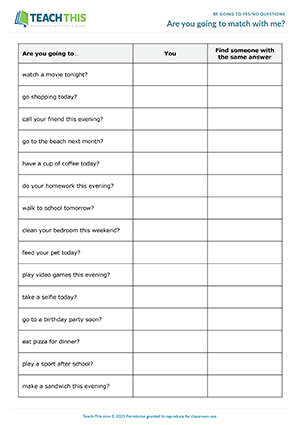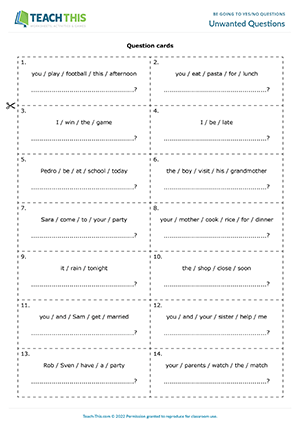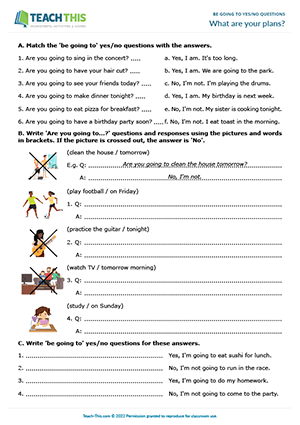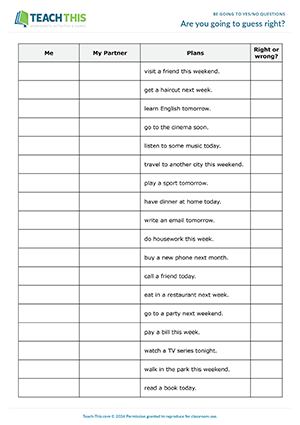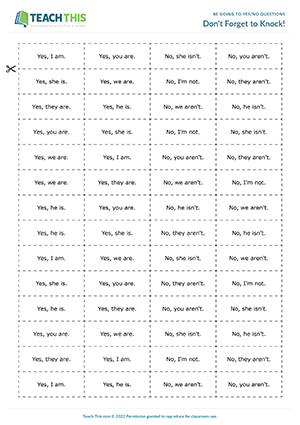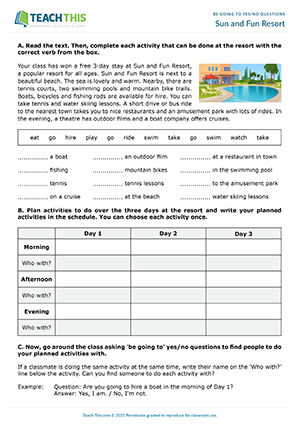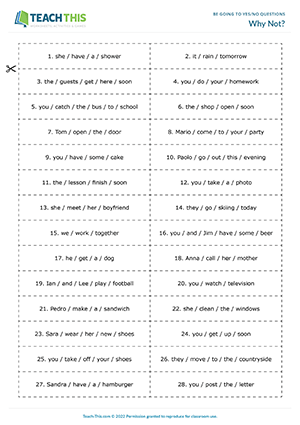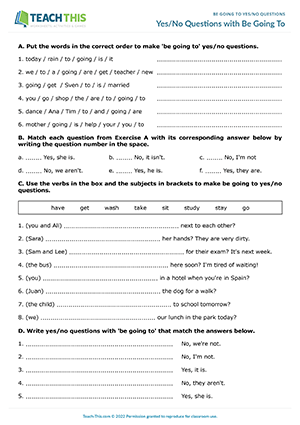In this insightful Are you going to...? speaking activity, students ask and answer be going to yes/no questions in order to find people who are planning to do the same thing as them. First, students answer Are you going to...? questions by writing short answers in the column marked 'You'. Students then go around the class asking and answering the Are you going to...? questions to find people with the same answers. When a student finds someone with the same answer, the two students write each other's name in the last column. When everyone has finished, students give feedback to the class on their shared plans.
In this fast-paced be going to game, students race to match be going to yes/no questions with short answers. To begin, students look at their question cards and write be going to yes/no questions from the prompts on their cards. One student then starts by turning over an answer card for everyone to see and reading it aloud, e.g. 'Yes, I am.' All the students then check their question cards to see if they have a question that matches the answer. The first student to place a matching question card next to the answer card on the table, saying the question at the same time wins, e.g. 'Are you going to play football this afternoon?' The two matching cards are then set aside, and the next student turns over an answer card. If a student puts down an incorrect question card, they are out of the round, and the other students race to put down a matching question. The first student to get rid of all their question cards wins the game.
This free be going to yes/no questions worksheet helps students learn and practice how to form questions about future plans. First, students match Are you going to...? questions with appropriate answers. Next, students write Are you going to...? questions and responses using pictures and prompts. After that, students write be going to yes/no questions for a set of answers. Finally, students complete a crossword using information from a weekly schedule and gap-fill question clues.
This enjoyable be going to guessing game helps students practice Are you going to...? questions and short answers. First, students read each plan and write 'I'm going to' or 'I'm not going to' in the column marked 'Me', depending on whether they plan to do the activity or not, e.g. 'I'm going to visit a friend this weekend.' Next, working alone, in pairs, students guess whether their partner is or isn't going to do the same things by writing 'He/She is going to' or 'He/She isn't going to' in the 'My partner' column, e.g. 'She isn't going to visit a friend this weekend.' Next, students take turns finding out if their guesses are right or wrong by asking Are you going to...? questions to their partner, e.g. 'Are you going to visit a friend this weekend?' Their partner then gives their answer. If the student guessed correctly, they put a tick in the last column. If not, the student puts a cross. The student with the most correct guesses at the end of the game wins.
In this fun be going to game, students race to make be going to yes/no questions that elicit specific short answers. In groups, students take turns picking up a short answer card, reading it aloud and placing it face-up on the table for everyone to see, e.g. 'Yes, she is.' The student then picks up a word card, reads it out and places it face-up next to the answer card, e.g. tomorrow. All the students then race to say a be going to yes/no question using the word that elicits the short answer. As soon as a student has a question, they knock their fist on the table and say it, e.g. 'Is she going to come to class tomorrow?' If the other students agree the question matches the answer and is grammatically correct, the student wins and keeps the two cards. If a student says a question without knocking first or makes an incorrect question, that student is out of the round, and the other students get to answer. The student with the most pairs of cards at the end of the game wins.
In this productive be going to yes/no questions activity, students plan activities to do at a resort and then ask and answer questions to find people to do their planned activities with. First, students read the introductory paragraph and imagine that they have won a three-day trip to the Sun and Fun Resort. Students then complete each activity that can be done at the resort with the correct verb from the box. After that, students plan activities to do over the three days at the resort and write them in a schedule. Students then go around the class asking be going to yes/no questions to find people to do their planned activities with, e.g. 'Are you going to rent a bicycle in the morning of day 1?' If a classmate is doing the same activity at the same time, they answer 'Yes, I am.' The two students then write down each other's names. If a classmate is doing something different, they reply 'No, I'm not.' Afterwards, there is a class feedback session to find out which student found the most people to do activities with.
In this engaging be going to yes/no questions game, students race to find and make yes/no questions with be going to that match certain answers. In groups, students take turns picking up an answer card, reading it aloud and placing it face-up for everyone to see. All the students then search the question cards on the table to find a question that elicits the answer. The first student to find the correct card, pick it up and use the prompt to make a suitable be going to yes/no question wins and keeps the two cards. If the other students think a question doesn't match or is grammatically incorrect, the student puts the card back and is out of the round. The other students then continue to search for a matching card or race to make a grammatically correct question. The student with the most pairs of cards at the end of the game wins.
This useful be going to worksheet helps students practice yes/no questions with be going to. First, students put words in the correct order to create be going to yes/no questions. Students then match each question with its corresponding answer. Next, students use verbs in a box and subjects in brackets to make be going to yes/no questions. After that, students write yes/no questions with be going to that match certain answers. Lastly, students complete a dialogue with question prompts in their be going to form.
Latest Free
Resources
- Identifying and Clarifying Problems
Dealing with Problems (B2)
Date Added: 1st of November
- The Bus Stop
Getting Around (B1)
Date Added: 1st of October
- Study Skills Showdown
Study Skills (B2)
Date Added: 10th of September
- Everyday Objects Bingo
Everyday Objects (A1-A2)
Date Added: 25th of August
- Action Verb Races
Actions (A1-A2)
Date Added: 18th of August
Latest Member
Resources
- That's a Really Good Question!
Adverbs of Degree (A2)
Date Added: 21st of January
- Manner Matters
Adverbs of Manner (B2)
Date Added: 21st of January
- Chinese New Year Bingo
Cultural Celebrations (B2)
Date Added: 20th of January
- Logical Fallacy Detectives
Critical Thinking (B2)
Date Added: 20th of January
- Editing in Action
Writing Exam Preparation (B1)
Date Added: 9th of January



